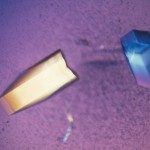Synthesis 2011, (6), 934-942
In the course of our work on infectious diseases, we were led to prepare 6-bromo-2-chloro-4-methylquinoline as a starting material. Since surprisingly little has been reported in the literature, the two synthetic steps to this compound were investigated. The synthesis involves a condensation between b-keto esters and 4-bro- moaniline and the cyclization of the resulting anilides into 6-bromo- quinolin-2(1H)-one, otherwise known as the Knorr reaction. The 1H NMR monitoring of the first step allowed us to optimize the condi- tions leading specifically to the anilide without the occurrence of the alternative crotonate. To illustrate the scope of our finding, few additional anilides featuring electron-attracting groups were pre- pared. The study of their cyclization revealed some unsuspected steric effect governing this second step. Aside from rectifying a few claims in this chemistry, this study led to a three-step preparation of 6-bromo-2-chloro-4-methylquinoline in 48% overall yield from 4- Bromoaniline




